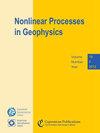利用资料同化的地震序列模型中的参数偏差
IF 2.4
4区 地球科学
Q3 GEOSCIENCES, MULTIDISCIPLINARY
引用次数: 0
摘要
摘要基于物理的地震预报的可行性取决于在模型和数据都存在不确定性的情况下,模型能在多大程度上被校准以代表地震情景。我们研究数据同化是否可以估计当前和未来的断层状态,即滑移率和剪切应力,在存在摩擦参数偏差的情况下。我们在具有速率和状态摩擦的Burridge-Knopoff弹簧块模型的零维(0D)泛化中使用顺序重要性重采样粒子滤波器进行状态估计以及组合状态参数估计。摩擦参数的微小变化会导致不同的状态轨迹和地震特征。在存在参数偏差的情况下,数据同化在估计故障状态方面的性能取决于偏差的大小。使用状态估计(R2 = 0.99)可以很好地补偿小的参数偏差(+ 3%),而使用状态估计只能部分补偿中间偏差(- 14%)(R2 = 0.47)。当考虑到模型误差和额外的重采样步骤增加粒子扩散时,R2增加到0.61。然而,当ε存在较大偏差(- 43%)时,只有状态参数估计才能完全解释参数偏差(R2 = 0.97)。因此,同时状态和参数估计有效地分离了摩擦和剪切应力的误差贡献,以正确估计当前和未来的剪切应力和滑移率。这说明了数据同化对地震序列估计的潜力,并为其在其他具有不确定参数的非线性过程中的应用提供了见解。本文章由计算机程序翻译,如有差异,请以英文原文为准。
On parameter bias in earthquake sequence models using data assimilation
Abstract. The feasibility of physics-based forecasting of earthquakes depends on how well models can be calibrated to represent earthquake scenarios given
uncertainties in both models and data. We investigate whether data assimilation can estimate current and future fault states, i.e., slip rate and
shear stress, in the presence of a bias in the friction parameter. We perform state estimation as well as combined state-parameter estimation using
a sequential-importance resampling particle filter in a zero-dimensional (0D) generalization of the Burridge–Knopoff spring–block model with rate-and-state
friction. Minor changes in the friction parameter ϵ can lead to different state trajectories and earthquake characteristics. The
performance of data assimilation with respect to estimating the fault state in the presence of a parameter bias in ϵ depends on the magnitude of the
bias. A small parameter bias in ϵ (+3 %) can be compensated for very well using state estimation (R2 = 0.99), whereas an
intermediate bias (−14 %) can only be partly compensated for using state estimation (R2 = 0.47). When increasing particle spread by accounting for model error and
an additional resampling step, R2 increases to 0.61. However, when there is a large bias (−43 %) in ϵ, only state-parameter
estimation can fully account for the parameter bias (R2 = 0.97). Thus, simultaneous state and parameter estimation effectively separates the
error contributions from friction and shear stress to correctly estimate the current and future shear stress and slip rate. This illustrates the
potential of data assimilation for the estimation of earthquake sequences and provides insight into its application in other nonlinear processes with
uncertain parameters.
求助全文
通过发布文献求助,成功后即可免费获取论文全文。
去求助
来源期刊

Nonlinear Processes in Geophysics
地学-地球化学与地球物理
CiteScore
4.00
自引率
0.00%
发文量
21
审稿时长
6-12 weeks
期刊介绍:
Nonlinear Processes in Geophysics (NPG) is an international, inter-/trans-disciplinary, non-profit journal devoted to breaking the deadlocks often faced by standard approaches in Earth and space sciences. It therefore solicits disruptive and innovative concepts and methodologies, as well as original applications of these to address the ubiquitous complexity in geoscience systems, and in interacting social and biological systems. Such systems are nonlinear, with responses strongly non-proportional to perturbations, and show an associated extreme variability across scales.
 求助内容:
求助内容: 应助结果提醒方式:
应助结果提醒方式:


